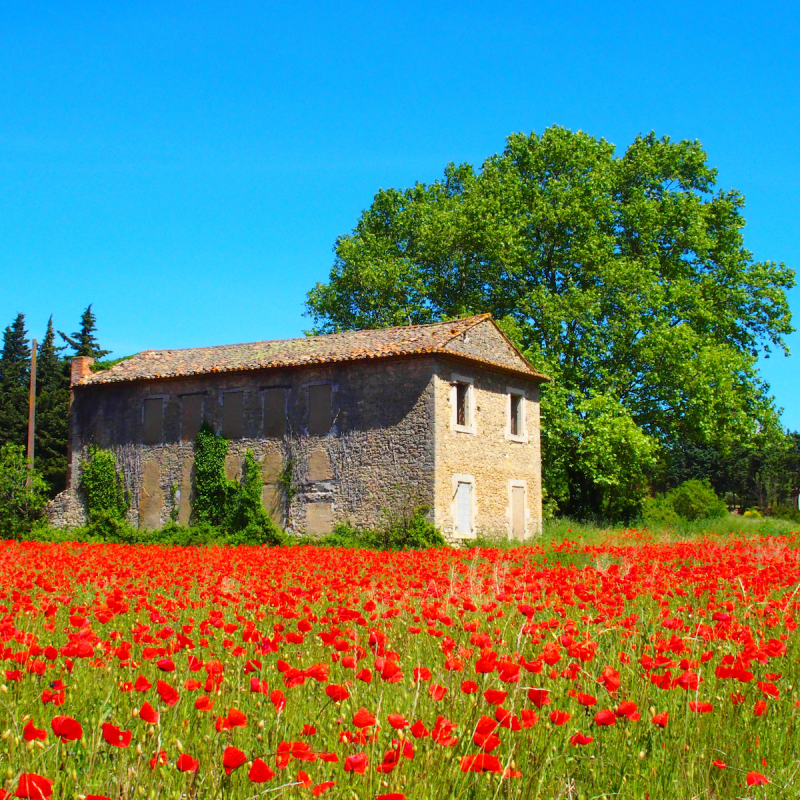
What would you like to do today? This question pops up over morning coffee at some point during most vacations. Even structured tours set aside downtime from group travel. If another museum, a 3-hour lunch, or idling the afternoon away do not sound appealing, how about an outing that is not on most tourists’ checklists?
Videos by TravelAwaits
I have listed a few of my favorite off-beat and unique ways to enjoy a little different travel experience if you find yourself in the South of France with a few hours on your hands.

1. Browse An Old Hardware Store — Then Spend The Night
Near the old port of Marseille, you will find Maison Empereur. Since 1827 this family business has been supplying customers with just about everything one could need, and then some. The wares are fashionably displayed on walls covered top to bottom. Shoppers will find antique toys in one corner of the shop and kitchenware, cleaning supplies, toys, bath soaps, and towels scattered elsewhere in this maze of wooden-floored rooms. This browser’s paradise has the feel of meandering through a movie set.
Dreamed of spending the night in a hardware store? Maison Empereur will provide. Above the store lies a spacious apartment perfect for an overnight in Marseille. Appointed in the style of the 19th century and designed to give the vibe of former times, the atmosphere is relaxing. The space is dimly lit and populated with antiques.
Guests are taken back to a time when being unplugged had no meaning. The distractions of Wi-Fi and television are not provided in this one-bedroom apartment. Instead, there is a deep zinc tub in which to soak by candlelight before turning in with a good book.
Pro Tip: The apartment in Maison Empereur rents for under 200 euros per night. Reservations are recommended.
2. Watch A Provençal Market Come Together
If you are an early riser, take to the streets on market day first thing. At least once a week most every town and village in the South of France is the scene of an open-air market.
Take a short stroll among the stands as they come together before securing your sidewalk table outside a café. From this front row seat, dip your croissant in your morning café and watch a French market come to life.

Best French Market Experiences
Arriving at a market in the early morning provides a glimpse into a way of life most marketgoers never experience. The commerçants travel from town to town to unpack their vans in a different town every day to arrange their wares for the expectant shoppers. Many of this lively group arose well before dawn, driving in the dark to that day’s marché.
The neatly packed vans and trailers arrive when the streets are empty and navigate to their appointed location in the village where the merchants will go to work. As they carefully arrange their merchandise for the soon-to-arrive villagers and tourists, their neighborly chatter fills the morning air.
Once prepared for the first shoppers, the vendors break for a quick meal before the crowds descend. Bottles of rosé are uncorked and placed atop small metal picnic tables that pop up among the booths displaying the day’s offerings.
Soon the merchants are at work, happily chatting with their regular customers and tourists strolling through the market. If you look closely as you shop, you will notice a beer, a glass of rosé, or a steaming coffee tucked behind the goods on display.
Pro Tip: Arrange your visit to arrive in a market town at least the night before the town or village’s scheduled market.

3. Picnic At The Pont Du Gard
The aqueduct built by the Romans in the first century, the Pont du Gard, is among the most recognizable structures in all of France. Over a million visitors a year take in this World Heritage site. The engineering feat once carried water over 31 miles from the nearby hills to the citizens of Nimes.
There is more than marveling at the bridge to do on the grounds at this landmark. The park is expansive, covering over 400 acres. Visitors can follow a marked trail through the garrigue, the low scrubland found in southern France. There are a well-done museum and two restaurants at the site as well.
The Pont du Gard provides a dramatic background for an outdoor lunch. Picnickers can relax along the river, marveling at the expanse as kayakers paddle through its arches on the Gardon River. Gaze at the Roman’s accomplishment with a glass of rosé in hand and a jambon beurre (ham on a baguette) and wheel of creamy Brie cheese on your plate.
Pro Tip: Arrive around midday and picnic along the right bank. The proximity of the parking lot allows you to return your picnic gear to the car before visiting the site. Then spend the afternoon exploring the aqueduct, the museum, and walking in the garrigue.

4. Cycle Where Roman Legions Marched
Roman Legions marched along the Via Domitia traveling from Rome to Spain. The route of this oldest Roman road, dating from the first century B.C., is roughly followed by today’s D900 roadway. Five miles west of Apt, the Pont Julien is the only intact Roman bridge along this famous route.
Until 2005 cars were still using the structure to cross the Calavon River near the hill town of Bonnieux. Today pedestrians and cyclists are the only users of this structure, which, like the Via Domitia, is over 2,000 years old.
The Pont Julien is now part of a dedicated cycling trail connecting Cavaillon to Apt. The Luberon Mountains and lavender fields provide the scenery along this 21-mile paved stretch. It is a relatively easy ride between these cities, both of which were important towns during the Roman Empire.
Pro Tip: Bike rental opportunities are abundant. Consider a side trip a few blocks off the bike trail to the Lavender Museum in Coustellet.

5. Photograph Flamingos In The Camargue
The remote delta of the Rhone River is found in the Camargue one hour south of Arles and about 70 miles west of Marseille. Marshes and rice fields line the roads taking travelers through the region heading toward the Mediterranean at Saintes-Maries-de-la-Mer. The Camargues’ famous white horses and black bulls graze lazily at ranches dotting the route to the sea.
Easy to access yet shielded from the roadway are the trails of the Parc Ornithologique Pont du Gau. Tucked among the marshes, this bird sanctuary provides a natural environment for visitors to experience some of the Camargue’s 350 species of birds. There are over 4 miles of paths winding through the marshes and brush in the 148-acre park.
The birds are plentiful and photogenic. The Camargue is a French stopover for flamants roses (flamingos) traveling across the nearby Mediterranean to and from Africa. At times, the park’s ponds are a sea of squawking pink feathers, some birds posing by standing on one leg.
This site is not exclusively for bird enthusiasts. The proximity to the wildlife in a natural setting presents up-close photo opportunities with flamingos and other birds.
Pro Tips: Open every day of the year, the average visit is 1 to 1.5 hours. Pets are not permitted in the park. There are wheel-chair accessible trails.

6. Check Out The Corkscrew Museum
The village of Menerbes towers in the distance just up the hill from the Domaine de la Citadelle Winery. The Provençal wines produced from the terroir of owner Yves Rousset-Rouard are served beyond the borders of France. But there is another reason to visit Domaine de la Citadelle other than to sample monsieur’s wine.
Le Musée du Tire-Bouchon (The Corkscrew Museum) is a private collection of some 1,200 items. There are 52 well-lit display cases lining the walls of this unique exhibition. Opened in 1993, it was the first corkscrew museum in the world.
The useful device comes in all shapes and sizes. There are some clever novelty models, collector sets, and many with historic value. The oldest corkscrew in the collection dates from the end of the 17th century.
Pro Tip: If your visit allows time for lunch in nearby Menerbes, reserve a table on the terrace at Bistrot Le 5.
7. Relax In The Shadow Of De Sade’s Chȃteau
Fifty years ago, Lacoste was a ghost town. The village languished under the crumbling castle that was once the home of the Marquis de Sade. The art community recognized the potential in the ruins, and today Lacoste is home to the Savannah College of Art and Design Lacoste.
Still perched above the ancient town is the one-time home of the infamous author of Justine and other disapproved works. De Sade’s castle, partially destroyed during the French revolution, was restored by Pierre Cardin, who bought the property in 2001, having taken an interest in the town.
The drive up the winding road is rewarded with an expansive view of the Luberon Valley. If up for a walk, the crest is also reached by winding through the village on a marked route. The park next to the castle ruins is adorned by several interesting objects d’art.
Pro Tip: Here you will find another shaded spot for a picnic on a sunny day in the South of France.
8. Art Immersion In A Stone Quarry
A short drive from Saint Rémy, you will find the Carrières de Lumières. This immersive art exhibit produced in what was once a working stone quarry has become a major attraction in the South of France.
Inside this 59,000-square-foot multimedia gallery, the spectacle is displayed on the quarry walls, which rise from 20 to 45 feet high above the limestone floor. One hundred projectors create a visual treat as the exhibit transitions across the quarry walls, bringing some of the tableaus to life. The sound of stonecutters saws has been replaced by music from 27 speakers wafting within the quarry walls.
The Carrières de Lumières exhibits run from March to early January when it is closed as a new show is prepared. The 2022 exhibition, Venice, La Serenissima, is a 40-minute journey through the Italian city’s art and architecture.
Since 2012 the works of Monet, Chagall, and Van Gogh among others have graced the walls of the Carrières. The music has ranged from bits of Janis Joplin to Carmen’s “Habanera.”
Located at the foot of the fortified town of Les Baux-de- Provence, this immersive art exhibition never disappoints the fellow travelers I have introduced to the Carrières de Lumières.
Pro Tip: Dress for a temperature of about 59 degrees F in the quarry. A welcome respite in the summer, but otherwise chilly. The exhibit is wheelchair accessible.
